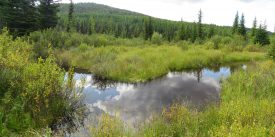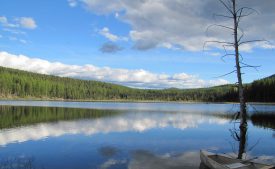by Julie Ashmore, Okanogan Highlands Alliance

“Calcareous fens are one of the rarest wetland types in the United States.” -Joe Rocchio, DNR Vegetation Ecologist
In January 2010, the non-profit organization Okanogan Highlands Alliance (OHA) responded to an extraordinary opportunity, purchasing 38 acres of wetland and 27 acres of adjacent forestland on the south end of Lost Lake (Okanogan County). While the Lost Lake Wetland and Wildlife Preserve sustains diverse plant and animal populations, both the wetland and adjacent forestland came to OHA with restoration needs. The forestland was aggressively harvested in 1992, so OHA has developed a management plan intended to maintain and enhance forest health, habitat and diversity while reducing weeds and fire danger. The wetland supports a wide variety of life, but the sensitive habitat was at risk from neighboring livestock. When cattle eat and trample wetland plants, native animal populations lose reproductive and foraging habitat. Through a partnership with the U.S. Fish and Wildlife Service, OHA installed fencing in the summer of 2011 to protect the wetland and its valuable diversity of species. Since that time, OHA has worked to make the Preserve more accessible to the public, to help increase interest and enthusiasm for stewardship in the Okanogan Highlands.
In establishing the Preserve, OHA aims to protect, restore and conserve the diverse plant and animal populations of Lost Lake, and provide educational and volunteer opportunities for community members who want to learn more and get involved. With help from the Curlew Job Corps, OHA has built trails on both the upland portion and in the transition zone leading to the edge of the wetland. The wetland interpretive trail loop complements the upland loop, providing easy hikes with ecological information. A work party is held each summer to help maintain trails, control weeds, and thin the forest. In addition to the trails, the Preserve offers a large, covered signboard that explains the function and value of healthy wetlands. Photos of the trail work, interpretive signs, and wetland and forest ecology are available at www.okanoganhighlands.org/restoration/lost-lake.

Lost Lake is a favorite recreation destination for many individuals and families who have been returning to the lake every summer for decades. The absence of combustion engines, combined with the natural beauty and ecological value of the lake, makes it a quiet gem in the Okanogan Highlands.
Lost Lake is known for its pristine common loon (Gavia immer) nesting habitat. Loons are struggling in the West, and the bird is a rare breeder in Washington State, where it is ranked as imperiled by the Natural Heritage Program and as a sensitive species by the Washington Department of Fish and Wildlife. Few nesting pairs remain in Washington, and loons no longer nest at all in California, Oregon or Idaho. In recent times, more chicks have been hatched at Lost Lake than any other lake in Washington, so it is critical habitat for this species.
In addition to supporting a diverse array of wildlife, Lost Lake hosts an exceptional plant community. Joe Rocchio, Vegetation Ecologist with the Washington Department of Natural Resources, has visited the Lost Lake Wetland Preserve several times and the site has been identified as a “Wetland of High Conservation Value” in our state. In describing its ecological importance, Joe noted: “Of particular interest is the calcareous fen, which are rare in Washington… and one of the rarest wetland types in the United States. Calcareous fens differ from other peatlands in that their pH is circumneutral to alkaline…. resulting in a unique set of plants which are able to grow in the fen. One of the more significant plant community types found at Lost Lake Preserve is the bog birch / slender sedge (Betula glandulosa / Carex lasiocarpa) plant association. In summary,…the long-term protection of this wetland complex would contribute to the conservation of these biodiversity treasures within Washington State.”
OHA welcomes local community members and travelers alike to enjoy the Lost Lake Wetland and Wildlife Preserve (for directions, see: www.okanoganhighlands.org/restoration/lost-lake/maps). On the north end of the lake, a Forest Service campground provides amenities, and a picnic table will be installed at the Preserve this fall.
OHA is a member-supported non-profit organization that works both to educate the public about watershed issues and to protect the natural beauty of the Okanogan Highlands, Learn more about their work in education and stewardship, restoration of the Myers Creek watershed, and their Mine Monitoring program to protect water quality on Buckhorn Mountain. Help make a difference at: www.okanoganhighlands.org/support. You can even listen to an original song about Lost Lake on the Highland Voices fundraiser album: www.okanoganhighlands.org/music/highland-voices.









